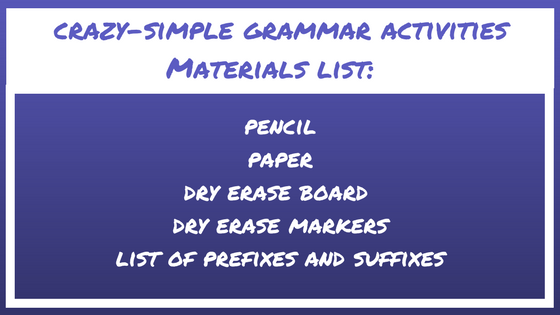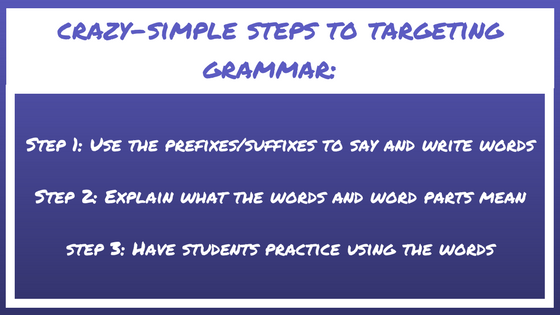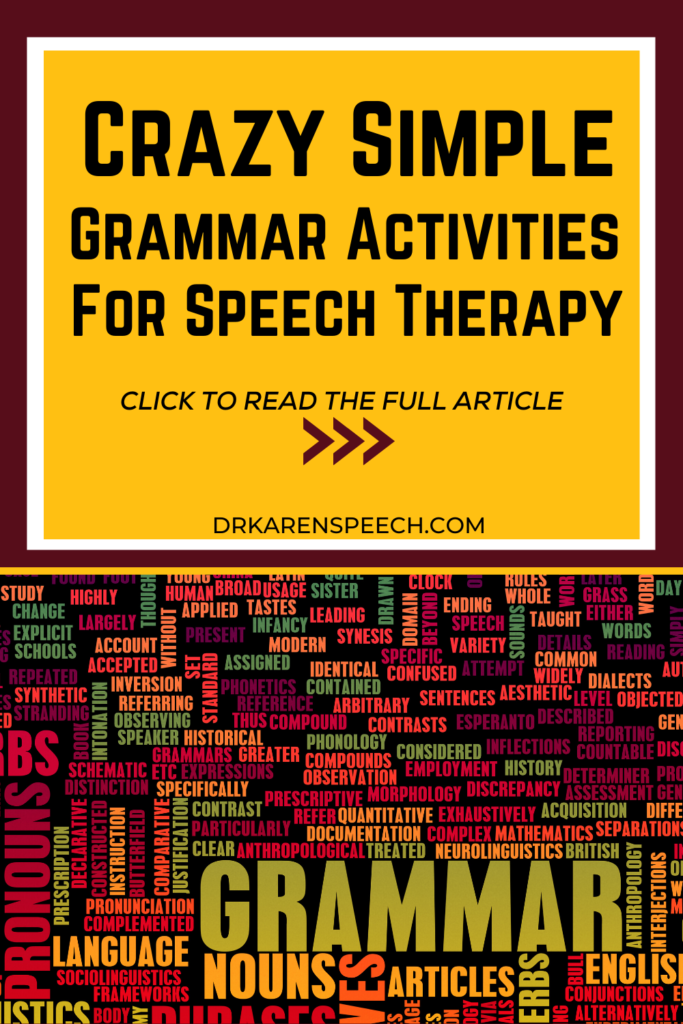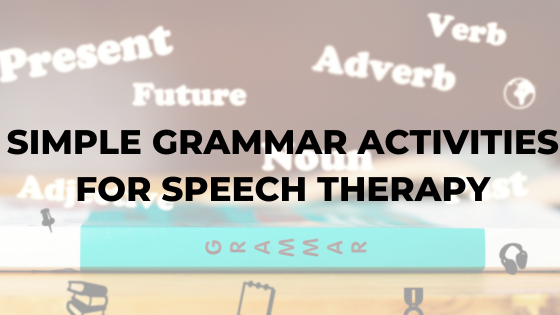One of the most comment objections I get when I talk about spelling/grammar intervention is, “But are my students ready for this?”
Specifically, I get this question a lot when it comes to building morphological awareness for the purpose of building reading and spelling skills.
Working on morphology, such as studying prefixes and suffixes, used to be considered something reserved for later elementary and secondary school.
But now we now know we can (and should) start working on it sooner rather than later (Bowers, Kirby, & Deacon, 2010).
This means that for any grammar strategy we use in speech therapy from early elementary on up, we want to make sure we’re hitting the right skills (like both inflectional and derivational affixes).
So what kind of students need this kind of intervention?
If your students have poor comprehension and vocabulary skills, you definitely want to include this type of intervention.
Additionally, if you have students who struggle with sentence structure and grammar, they could also be the missing link for them.
And of course, if you have kids who struggle to read and/or spell…and phonological awareness training doesn’t seem to be enough for them, adding a morphological component could be the piece they’re missing.
In this blog article, I outlined the results of a study by Apel and Henbest (2016) that showed students in 1st, 2nd, and 3rd grade have the ability to use knowledge of affixes to infer meanings of unknown words.
This study also showed that morphological awareness skills are a unique predictor of word reading and reading comprehension; which means that students who don’t know meanings of affixes (i.e., suffixes and prefixes) are likely to have poor reading and spelling skills.
These are also students who are likely to end up on our caseload for language issues.
While phonological awareness and morphological awareness are correlated, we can’t always assume that addressing one will automatically result in the other improving.
Instead, we want to tie multiple linguistic features together(e.g., morphology, syntax, phonology, etc.; Apel & Lawrence, 2011).
Especially for those students who are in obvious need of some type of grammar intervention.
Fortunately, you as the SLP are in the unique position to help. Especially if you have a couple resources like the Word Study Toolkit for SLPs, and a protocol for using it in an evidence-based way.
So let’s lay the ground work for what you should actually be doing in therapy.
Here’s what you’ll need to do this protocol: A pencil. A piece of paper.
And that’s pretty much it.
Just kidding…sort of. In theory, once you get good at this and have it “in your head”, you could deliver a killer therapy session with just these two things.
Effective grammar activities for speech therapy don’t have to involve massive lists of materials.
But, since sometimes we need some tools to help rest our brains (since I know you won’t necessarily want to memorize every single prefix and suffix), I’ll tell you a couple other materials that may come in handy as I’m explaining this.
Here’s the official materials list:
Pencil
Paper
Dry erase board
Dry erase markers (dry erase board and markers could be in addition to or instead of pencil and paper)
List of prefixes and suffixes (could be an actual “list”, or could be sets of flashcards, or word bank on a worksheet).
The important thing to note is that you COULD integrate apps, grammar worksheets, flashcards, or even games when you do grammar activities for speech therapy, but you don’t HAVE to.
As long as you have something to write with you can do this…so having a limited budget isn’t a barrier to getting this done.

There are a couple good resources for SLPs planning grammar activities for speech therapy that include lists of prefixes and suffixes.
I include one in the Word Study Toolkit for SLPs, in addition some other sets of words that will help you build orthographic awareness skills that improve spelling.
Now that you know what materials you need, let’s get to the steps of the protocol:
Step 1: Use the prefixes/suffixes to say and write words
All you are doing here is picking a prefix or suffix, and thinking of words that would have that prefix/suffix on it. You could also start with the root or base word and then add prefixes or suffixes to that to come up with new words.
While you’re doing this, you can point out how words are spelled and how they are pronounced. This can help build phonological representations of the words (Sutherland, 2009).
You can also draw students’ attention to the way the different morphemes are spelled to build orthographic knowledge (Apel, 2011; Ram, Marinellie, Beningo, & McCarthy, 2013).
Eventually, we want our students’ ability to spell morphemes to be automatic so that they perceive the morpheme as a unit, rather than individual sounds. I explained why here in this article.
Step 2: Explain what the words and word parts mean
There’s a chance you may be doing this simultaneously with the first step. Your grammar intervention will be equally effective either way. All you’re doing here is explaining what the word parts mean (each morpheme individually), and then explaining what the words mean altogether.
For example, a word like “retell” has the prefix “re”, which means “again”, and “tell”, which means “to explain or report”. Altogether, the word means “to explain again.”
Isolating the morphemes is important to doing grammar activities for speech therapy because even young students are capable of inferring meanings of unknown words using their knowledge of word parts.
Additionally, suffixes can change the class of words, which changes how we use them in sentences. Making our students aware of these subtle changes in word meaning can help our students use words effectively in context. This is a critical piece to making sure that our grammar activities for speech therapy are evidence-based.
If you feel like this could get boring, feel free to mix it up and vary your presentation, or add a game format. Here’s an example of how to add variety from Hallie Sherman from Speech Time Fun, where she uses some low-cost materials to turn prefix/suffix work in to a game.
Step 3: Have students practice using the words
This one is deceptively simple, but effective. Active and extended use of words is a critical part of grammar intervention because it helps solidify robust vocabulary knowledge (Walsh & Blewitt, 2006; Marulis & Neuman, 2010).
All we are doing here is giving our students the chance to practice using words in different contexts and situations, so they become more flexible with their language use.
This could be as simple as saying and writing sentences with words you’ve created with different affixes and roots, or it could involve reading/writing short stories using the words. You could also draw pictures or describe situations that relate to the words.
This activity doesn’t require a lot of planning and materials, so it’s ideal for an SLP doing grammar activities for speech therapy.
While there isn’t a set of materials required for you to do this, it can be helpful to have a few materials handy. This resource by Shannon Werbeckes from Speechy Musings is one of the best SLP-created resources I’ve been able to find on TpT, because she nails the “active and extended use” aspect with all of the extension activities with easy-to-use grammar worksheets.
I’ll be reviewing Shannon’s resource in depth along in an upcoming article, so be on the lookout for it. She also has an overview and video with a description on her website in this blog post.

If you work with kids with language disorders..
You’re probably already starting to realize that phonological awareness impacts reading performance.
Even so, I often get questions like:
“What if my students can’t read/are poor readers?” “Can I work on morphological awareness?” “Are they ready?”
If weak morphological awareness is contributing to their reading and spelling difficulties, the answer is, “Yes”.
I share how to do that in the Word Study Toolkit for SLPs.
This is a huge problem-especially for students with language disorders who don’t naturally catch on to these skills.
When students aren’t able to fluently and accurately decode complex words they risk missing out out on years of valuable vocabulary exposure in elementary school…
Comprehension suffers…and so does writing quality.
And worst of all, students start to hate reading, and it impact their self-esteem.
I know how frustrating it can be to see your students struggling to read and spell, but feeling unsure of how to help.
But the good news is that it doesn’t have to be this way.
I’ve designed the Word Study Toolkit to give you a road map so you know exactly how you can support your students’ spelling and reading skills.
But I know you don’t have time to go digging for lists of prefixes, suffixes, roots/bases, and multiple meaning words.
So I’ve done the grunt-work for you and put them in to the toolkit just for you.
Here’s what’s inside the Word Study Toolkit:
✅Over 200 flashcards with prefixes, root/base words, suffixes, and multiple meaning words to build strong reading and spelling skills.
✅Word lists with key orthographic concepts, so you have a quick guide to important word parts needed for strong vocabulary skills.
✅Descriptions of 17 key concepts for building morphology/orthography skills
✅All flashcards and word lists have definitions, so your students actually remember how words are spelled.
✅BONUS: Video tutorials with a quick-guide for using the toolkit to build reading and spelling skills.
>>>Take a peek at what’s inside the toolkit here.
References
Sutherland, D. (2009). Phonological representations, phonological awareness, and print decoding ability in children with moderate to severe speech impairment. (Doctoral thesis, University of Canterbury, Christchurch, New Zealand) Retrieved from: https://ir.canterbury.ac.nz/bitstream/handle/10092/1292/thesis_fulltext.pdf;sequence=1


